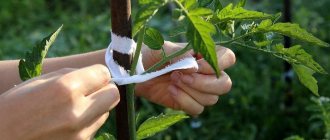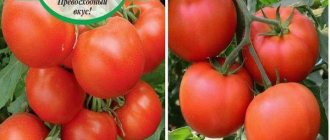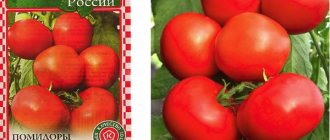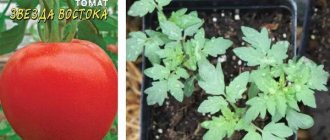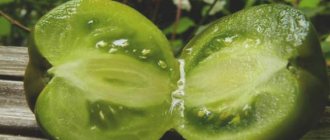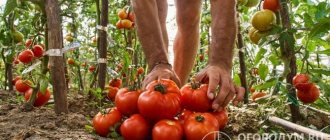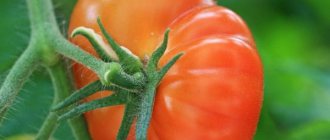Grandma's Kiss is a tomato that attracts many gardeners. A large number of farmers prefer to grow early-ripening tomato varieties. This choice is due to the fact that many regions of the country do not have the necessary climatic conditions for long-term cultivation of cold-resistant vegetables such as tomatoes.
One of the popular early-ripening subspecies is the Grandmother's Kiss tomato. However, before buying seeds and growing a tomato, you need to read the description of the variety and read at least a few reviews from summer residents.
Description and characteristics of the variety
The tomato is mid-early, the fruits ripen in 90-100 days. When mature, they are bright yellow, flat-round in shape and weigh 450-600 g.
The plant is medium-sized and its height exceeds 120 cm. The leaves are potato-type.
The tomatoes taste sweet with a slight fruity note, the flesh is juicy and oily. They are suitable for fresh consumption, cooking, and homemade preparations. Preservation is possible if there are small fruits.
How to choose a site
It is important to choose the most optimal place for planting seedlings, because future productivity will depend on it. Tomato is a plant that loves warmth, therefore, the place in the garden should be appropriate. Its southern part will become completely ideal.
Important ! It is in the southern part of the site that the plants will be able to warm up as quickly as possible. The result is that they will grow much faster. It is also important to plant plants where they will be protected from the wind.
Planting in a greenhouse
Seeds are planted using the seedling method. Preparation for it involves a number of actions.
Seeds are checked for germination before planting. To do this, place them in a prepared salt solution in a glass for 10 minutes. The empty ones will be at the top, and the full ones will remain at the bottom.
Next, the seeds are prevented from diseases by washing them in a manganese solution.
For the seedling method, prepare a container and soil for it. It should consist of soil and humus or peat in equal quantities and be as loose as possible so that oxygen can freely pass to the roots. The use of sand is allowed.
Planting is planned in mid-March, so that healthy, strong seedlings can be planted in May, when there is no frost.
The event consists of the following stages:
- sowing seeds in moist soil in containers at a depth of 1 cm and a distance of 2 cm from each other;
- covering the container with film and keeping the room temperature at least 15 degrees;
- planting seedlings at the stage of 2 true leaves in separate containers made of peat or plastic;
- on days 50-60, plants are planted in the ground according to a 50x50 cm pattern, that is, 4 plants per square meter.
Reviews from those who planted
Anna, 37 years old: “I’ve been growing the ‘Granny’s Kiss’ variety for several years in a greenhouse. I fertilize with mineral and organic mixtures. Last time some bushes reached 2 meters in height! The leaves of the plant are unusual, and the fruits are very tasty. I use tomatoes in salads, and I also seal small tomatoes in jars for the winter.”
Zinaida, 51 years old: “The tomato variety “Grandma’s Kiss” is very productive, and the trunk of the bush reached a height of 180 cm. The tomatoes have an excellent taste and are suitable for consumption raw. I canned large fruits by cutting them into four parts.”
Characteristics of the Grandmother's Kiss yellow tomato, planting nuances, reviews
Many gardeners are engaged in growing early-ripening tomato varieties. And this is not without reason - in many regions of our country it is quite difficult to grow other varieties, which is greatly influenced by the climate. Cold weather simply “kills” plantings. But, the Grandmother's Kiss tomato (yellow) can develop perfectly even in extreme cold. Before you start growing it, you should read about its features and planting secrets.
Main technical characteristics of the variety
The Grandma's Kiss variety is an early ripening variety. So, the first harvest can be obtained just 100 days after planting the berries. This variety of bushes is tall - they can grow up to 1 m. Therefore, the gardener will have to take care of staking the plants so that they do not break.
The main advantage of this tomato is the amazingly beautiful fruits that grow yellow. They have a round, slightly flat shape, and are slightly grainy on the surface. Each growing tomato is quite large - it can weigh up to 500 grams.
Tomatoes are fleshy and juicy, therefore, they are often used to prepare various vegetable salads. Due to their large size, they are very inconvenient to preserve, but there is a way out - cut the tomato into several parts.
How to plant
Gardeners recommend starting to plant this variety in early spring, so that by summer the seedlings can be planted in the ground. The planting process itself is divided into several stages.
Preparation of planting material
Seeds must be properly treated before planting. To make the growth process as fast as possible, they need to be slightly wet. For this, it is best to use small fabric bags. The seeds are distributed in them, moistened, and left for 12 hours. The fluid is changed every 2 hours.
Land preparation
Many new gardeners believe that to germinate seedlings they need to use exclusively mineral-rich soil. In reality, this is not at all the case. It is better to take soil with small admixtures of useful minerals, since these seedlings require slightly different care.
Planting material should be planted in a mixture of soil made from sand and sawdust. It will contain the required amount of substances necessary for the normal development of the plant.
Disembarkation
As soon as the planting material has germinated and the soil has been prepared, you can begin planting the seedlings. The best option for a container for planting is small hills of soil - this will greatly simplify the process of planting tomatoes in open ground in the future.
The holes for planting should be about 2 cm deep. Next, they need to be sprinkled with remaining soil and watered generously. Then the plants are sent to a warm, bright place for active development. If the plantings receive little sunlight, their stems will be very weak. Therefore, seedlings should be illuminated for at least 14 hours in 24 hours.
Transplantation into the ground
The procedure can be started when the night frosts stop completely. If the temperature is very low, the plants will simply die.
How to choose a site
It is important to choose the most optimal place for planting seedlings, because future productivity will depend on it. Tomato is a plant that loves warmth, therefore, the place in the garden should be appropriate. Its southern part will become completely ideal.
Land preparation
You should start preparing the soil for planting in the fall. The soil should be systematically fed with organic and mineral fertilizers, as well as dug up.
Immediately before planting, it is worth adding potassium-based fertilizers, mineral compounds and superphosphate to the soil.
Landing in the ground
The holes for planting should have a depth of about 13 cm. So that in the future the bushes do not “interfere” with each other, it is worth maintaining a distance of 40-50 cm between them. After the holes are formed, the plants are placed in them and sprinkled with earth. After this, with the time of formation, the tomatoes will have to be tied up.
Resistance to pests and diseases
The variety can become infected with a disease such as blackleg. The neck of the root crop gradually begins to acquire a dark color and rots. To prevent this, it is enough to reduce watering and water the bushes with Fitosporin.
The plant is also not “insured” from mosaic. Pathology manifests itself in the form of curling leaves and the appearance of rotten areas on them. There is only one way to fight it - uproot the affected bushes and destroy them.
The Grandmother's Kiss tomato is not afraid of most pests. But, you should take care that the plant is “attacked” by the cutworm. She can chew stems and leaves. Therefore, the bushes need to be inspected from time to time and these insects must be manually removed.
Reviews and recommendations from gardeners
Anatoly Nikolaevich, 32 years old, Siberia
“This variety can become infected with late blight and septoria. It has already been proven more than once by both me and my neighbors in the dacha. But, you can use a folk remedy to fight the disease: chop 200 grams of garlic and pour a couple of glasses of boiling water, leave for a day, strain after fasting, and pour into a bucket of water. Then add 1 gram of potassium permanganate. Treat plants with a sprayer every 2 weeks."
Elena Petrovna, 29 years old, Moscow region
“I also want to share a secret - if the seedlings have grown too large, then I plant them this way. I dig a hole of suitable depth, pour half a bucket of water into it, and wait until it is absorbed. I deepen the roots of the plant into this “swamp”, then twist the stem in a circle in the same hole, and cover it with soil. I do everything in such a way that the stem remains approximately 20 cm above the ground. There is no need to tear off the leaves - they will rot on their own. But the stem will give additional roots under the soil. This method can even strengthen the plant.”
Recommendations for increasing yield
To get a high yield, you need to comply with the thermal regime. Air humidity should not be too high. It is not recommended to do dense plantings, because with dense plantings the plants do not have enough nutrition and sunlight.
- Tomatoes need to be pinched, especially in the lower part of the plant. This will allow nutrients to move more actively to the upper parts of the plant.
- It is not recommended to water the leaves, much less the flowers and ovaries. It is best to water the bushes at the root with warm water. Watering is organized in the morning or evening hours; at this time, plants use nutrients more efficiently.
- During the period of fruit ripening, watering is reduced. In the greenhouse where tomatoes are grown, there must be air circulation.
- An important condition for obtaining a high yield is fertilizing with phosphorus and potassium fertilizers. During the period of fruit formation, tomatoes are treated with stimulants and growth regulators.
- If the area is sloping, the beds where tomatoes are grown should be placed across the slope so that the water evenly moistens the entire bed.
- The soil on which tomatoes are grown must be warmed by the sun. The beds are evenly moistened; water should not stagnate on them. It is recommended to grow tomatoes in high and narrow beds, as air exchange occurs easier in them.
- The soil for growing tomatoes should not be too dense; seedlings should not be planted in freshly dug soil rich in organic matter. Before planting seedlings, the soil is allowed to rest and settle for 5 days.
- After planting the seedlings, the soil around the plant is compacted, watered abundantly, then the hole is mulched. Potted seedlings guarantee a high yield of the Babushkin Kiss variety.
Ways to combat late blight:
- compliance with the rules of agricultural cultivation;
- burning disease-affected bushes;
- treating the plant before the ovaries appear with 3-4% Bordeaux mixture, 0.3% copper oxychloride solution.
Granny's Kiss tomatoes will delight you with neat round yellow fruits. They are good both for consumption and for canning for the winter, processing into paste, juice, and ketchup. The ripening of the crop occurs in waves.
